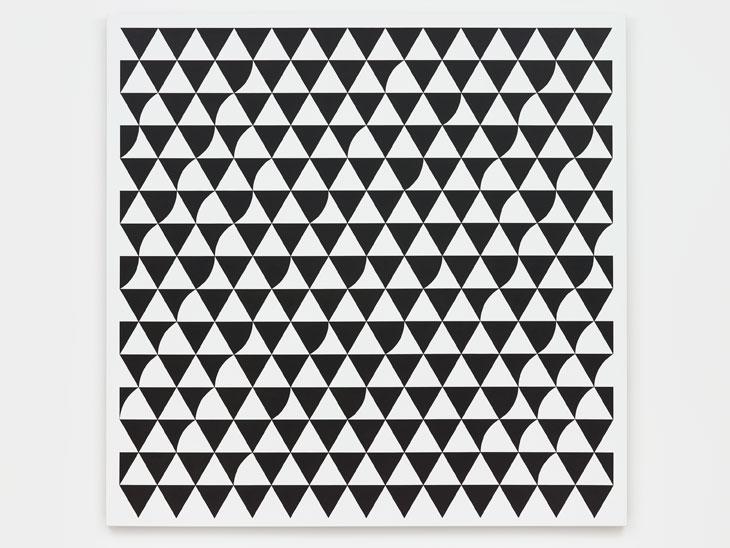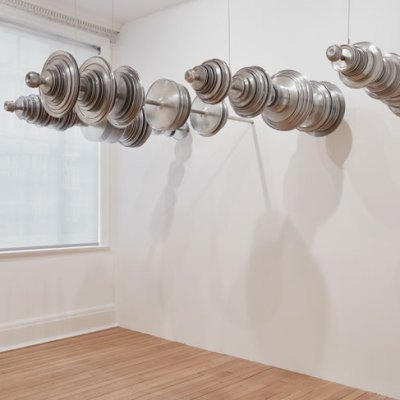The benches placed in museums offer to the weary a chance to sit back and lose themselves in a painting for a time, to really soak up its details and bathe in its oily surface. In Thomas Bernhard’s novel Old Masters: A Comedy, the character of the 82-year-old critic Reger has for 30 years spent four or five hours, every second day, sat on the same settee in front of Tintoretto’s White-Bearded Man in the Bordone Room of Vienna’s Kunsthistorisches Museum. It has become for him a ‘mental production shop’, a place ideally suited to calm and quiet contemplation.
The white pew facing Bridget Riley’s Cascando (2015) in David Zwirner’s rear gallery for the current exhibition of her recent paintings at Zwirner’s London space, by contrast, feels more like a dare – a challenge to the sensorium. How long can you sit and continue to stare at this dense thicket of triangles and sly curves in acrylic on polyester before the lines start to whirl and dance, spiralling and cascading in an effect not entirely dissimilar to that proceeding from the consumption of LSD? Far from being opportunities for calm, detached contemplation; the paintings of Bridget Riley are a visceral assault on the senses.
Rustle 6 (2015), Bridget Riley. © Bridget Riley 2017, all rights reserved. Courtesy David Zwirner, New York/London

Having studied at the Royal College of Art in the early 1950s alongside Frank Auerbach and Peter Blake, Riley would come to be associated with a style of painting that could scarcely be more different from her peers. Influenced equally by the pointillism of Seurat, the dynamism of the Futurists, and the abstractions of Pollock, her work from the ’60s onwards consisted of flat planes of simple, repeated shapes (first in black and white, later with colour) assembled in often dizzying configurations. Working contemporaneously to such continental Op artists as Victor Vasarely and Julio Le Parc, Riley was included in the landmark exhibition ‘The Responsive Eye’ at MoMA in 1965, which emphasised the active role of the viewer and the potential slipperiness of seemingly objective geometric forms.
Looking now at Riley’s work from that period, one is struck anew by its elusiveness. Included in the present show are several early works, including Black to White Discs (1962/1965). On one level, the work could scarcely be more simple: a square canvas, on which is painted a diamond of little circles gradually fading from stark black on the right-hand side to ever-paler greys on the left, finally evanescing altogether. But the effect is mesmerising, the painting’s intentions so elusive as to come across like a force of nature, even as it recalls the cool repetition of mass-produced graphics.
Portrait of Bridget Riley, 2018. Photo: Johnnie Shand Kydd. © Bridget Riley 2017; all rights reserved. Courtesy David Zwirner, New York/London.

With many artists, viewing their preliminary studies promises a chance to catch the creator at it, to see them in the process of working things out and slowly finding a particular form. No such behind-the-scenes glimpses are offered with Bridget Riley. The five ‘studies’ included in this show (one for Black to White Discs from 1961, and four for various iterations of the recent Measure to Measure series) are finished with the same perfection and precision as the final products. They’re just a bit smaller. But there no denying that a change takes place when the compositions reach their intended scale. There are five full-size versions of Measure to Measure in this show, numbered 14, 2, 3, 7, and 13, dating from 2016–17, each one a nine-by-nine grid of pale green, brown, and violet discs in not-quite-symmetrical arrangements. Gazing up at these paintings feels like apprehending some modern species of the sublime.
‘Bridget Riley: Recent Paintings 2014–2017’ is at David Zwirner Gallery, London, until 10 March.



